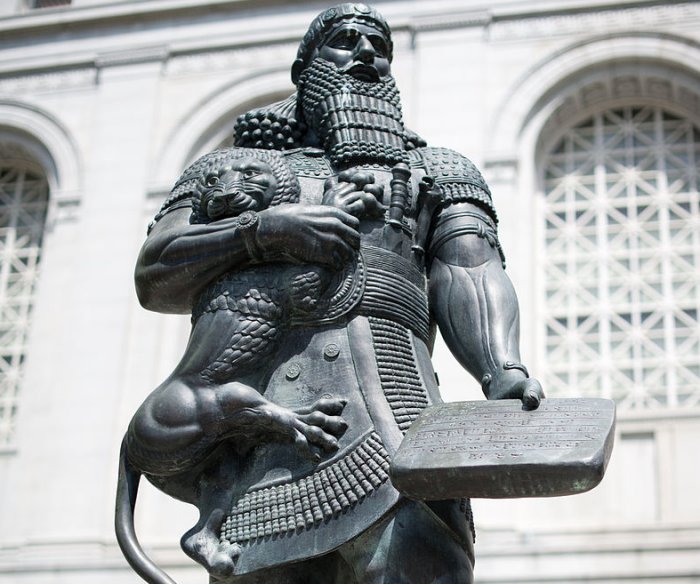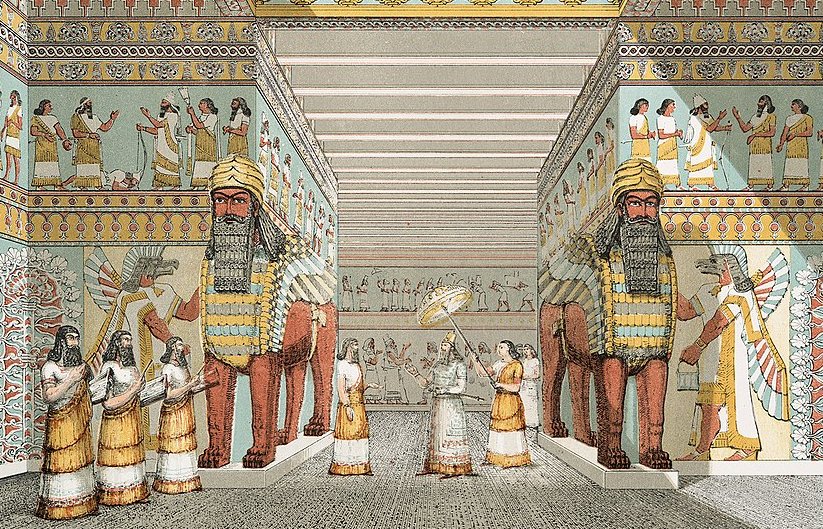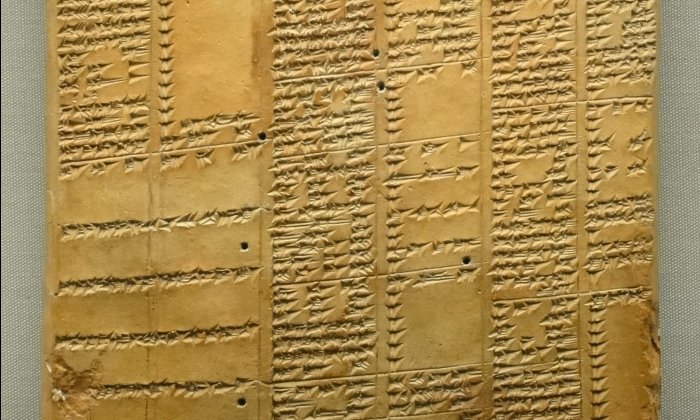Ashurbanipal – Last Great Ruler Of Assyria And His Famous Well-Organized Library
Angela Sutherland - AncientPages.com - In the Old Testament, Ashurbanipal is mentioned in the Book of Ezra, 4:10 - "and the other people whom the great and honorable Ashurbanipal deported and settled in the city of Samaria and elsewhere in Trans-Euphrates."
A contemporary bronze statue of Fred Parhad depicting Ashurbanipal. San Francisco, United States. Image credit: Almonroth - Public Domain
Considered the last great ruler of his country, Ashurbanipal, the King of Assyria (669-631 BC), is famous for being one of the few ancient kings who could read and write.
During the Ashurbanipal's reign, Assyria flourished, which was attested by their military power and the country's culture, arts, and magnificent palaces of Nineveh.
Ashurbanipal was the son of Esarhaddon (Esar-haddon), who reigned 681-669 BC, and grandson of Sennacherib, king of Assyria (705/704–681 BC). His father's eldest son, Sin-iddina-apla, would take over the power after him, but he died, so the next in line to take control was Ashurbanipal.
Selected as heir by his father in 672 BC, Ashurbanipal ascended the throne of Assyria after his father's death in 668 BC. At the same time, his brother, Shamash-shum-u-kin, became the king of Babylon, but he could not act independently, as the last word was that of Ashurbanipal.
Artist's impression of a hall in an Assyrian palace from The Monuments of Nineveh by Sir Austen Henry Layard, 1853. Sir Austen Henry Layard, 1853 - British Museum - Public Domain
At the time of Ashurbanipal's coronation, Assyria stretched from northern Egypt to Persia, but it was still much to do. For much of his early years of reign, Ashurbanipal spent fighting uprisings in Egypt, earlier conquered by his father Esarhaddon, who had finally brought parts of Egypt under Assyrian control.
"Ashurbanipal would manage to expand upon it. Victories on the Arabian Peninsula, Phoenicia, and Palestine throughout Esarhaddon and Sennacherib's reign had placed these territories firmly under Assyrian control, and they made kingdoms further north, towards Anatolia, fearful, resulting in voluntary offers of friendship and tribute. Because these territories were so well fortified, Ashurbanipal could turn his attention to extending Assyrian control further into Egypt. " 1
In 668 BC, Ashurbanipal defeated the Egyptian King Taharqa, and in 664-663 BC, the Assyrians invaded Egypt again, as they took control over the significant Egyptian cities of Thebes and Memphis.
"Assyria extended further than it ever had before…. Assyria already controlled large tracts of land throughout Mesopotamia, Anatolia, Palestine, Syria, Arabia, and Egypt, putting considerable stress on its ability to manage and maintain its own territory." 1
Artist's impression of Assyrian palaces from The Monuments of Nineveh by Sir Austen Henry Layard, 1853. Image credit: Austen Henry Layard, British Museum. Public Domain
Now it was time to deal with Assyria's hostile neighbors, particularly the kingdoms of Urartu, Medes, Elam, and Babylonia. The most effective campaigns of Ashurbanipal were those against Elam, an ancient enemy of Assyria, and against his brother, Shamash-shum-ukin.
At last, Elam was defeated. Its cities were destroyed in a series of campaigns in 665 BC and 647–646 BC. The people of Elam were killed, and the land was left barren and undefended.
Tired of being Ashurbanipal's puppet king, Shamash-shum-ukin campaigned against his brother in 652 BC, having supporters among the Babylonians, Arameans, Elamites, and Arabs, but their help was not powerful enough. At the time, Ashurbanipal took control over Babylonia; his brother committed suicide.
Library - Gathered By Literate, Intelligent Ruler
Ashurbanipal is remembered as one of the most educated rulers in the Mesopotamian region. He was literate in Sumerian and old Akkadian scripts, which made him a remarkable historical figure with an uncommon gift among the rulers of his epoch.
The oldest surviving royal library in the world belongs to Ashurbanipal, King of Assyria (668 – c. 630 BC). The first systematically collected and organized library in the Middle East, located at Nineveh, is undoubtedly Ashurbanipal's outstanding achievement.
At the beginning of 1845 AD, British Museum archaeologists unearthed more than 30,000 clay tablets and their fragments at Assyria's capital, Nineveh (today - modern Kuyunjik).
The library's systematically collected and organized material included tens of thousands of literary works in cuneiform tablets. Many of them were pre-scientific works, an ancient attempt to explain events in the world. Some others were even scientific.
The Banquet Scene _ Ashurbanipal and his wife Libbali-sharrat depicted dining in Nineveh. The severed head of Elamite King Teumman is hanging in a tree to the left, and his hand holding a royal wand is fixed in the tree to the right. British Museum. Source
The collection also included religious texts, and some tablets preserve the more complete versions of the poem of Gilgamesh recorded in the Sumerian and Akkadian languages. Thanks to Ashurbanipal's library, the text of this poem managed to survive to the present day, and so did other literary works like Enuma Elish's creation story, the myth of Adapa, the first man, and stories such as the Poor Man of Nippur.
The unearthed cuneiform writings were spread out into many rooms according to the subject matter. The tablets include hymns, prayers, chants, several thousands of treatises on geography, history, mathematical tables, medicine, grammar, Sumerian -Akkadian dictionaries on astronomy and astrology, and business documents involving contracts, sales, and loans.
Even folk tales are a part of the Ashurbanipal's remarkable collection. All these works represent an enormous source of information about Assyria and Mesopotamia's history.
In addition, the ruler of Assyria also promoted the artistic working of stone in architecture and sculpture.
In the introduction to his 'Annals' inscribed on his great ten-sided prism in the British Museum, he says: 'I, Ashurbanipal, within it (i.e., the palace) understood the wisdom of Nebo, all the art of writing of every craftsman, of every kind, I made myself master of the mall (i.e., of the various kinds of writing').
He was a very efficient ruler. While organizing his famous library, Ashurbanipal renovated Nineveh, ran the country, and participated in his well-organized military campaigns.
Cuneiform synonym list tablet from the Library of Ashurbanipal. Neo-Assyrian period (934 BC - 608 BC) source
Looking at monumental depictions of Ashurbanipal, we see him busy with hunting, archery, and horse riding. Hard to say whether he had enough time for these activities or whether these depictions show his high qualities and capabilities as a ruler of the great empire.
The Assyrian Empire was vast, and to use only the power of the army's strategic tactics was not enough. Ashurbanipal knew it, so he used his other skills as a diplomat and scholar to succeed as Assyria's greatest ruler. Based on contemporary sources in the form of correspondence and Ashurbanipal's autobiographical works, we know that he was an active ruler, engaged in his work, often dealing with questions considered significant for the empire. He participated in the appointments of prefects and governors and oversaw building of statehouses and other structures.
After Ashurbanipal's reign, the Assyrian kingdom started to decline. It was not because he was an inadequate or incompetent ruler. Assyria was still a strong empire from the inside. However, it became weakened due to constant attacks from hostile neighbors. The kingdom had more enemies than friends or supporters.
At the time of his reign (669–627 BC), Assyria spanned from the Caucasus Mountains (modern Armenia, Georgia, and Azerbaijan) in the north to Nubia and Arabia in the south, and from the East Mediterranean, Libya, Egypt, Cyprus and Antioch in the west to Persia, Cissia, and the Caspian Sea in the east.
The ruler's death remains a mystery. Shortly afterward, the Assyrian Empire fell, and the great city of Nineveh was destroyed in 612 BC. Its ruins were lost to history for a very long time until the 1840s.
Written by – A. Sutherland - AncientPages.com Senior Staff Writer
Updated on December 08, 2022
Copyright © AncientPages.com All rights reserved. This material may not be published, broadcast, rewritten or redistributed in whole or part without the express written permission of AncientPages.com
Expand for referencesReferences:
- History, Captivating. Assyrian History: A Captivating Guide to the Assyrians and Their Powerful Empire in Ancient Mesopotamia
Kriwaczek, P. Babylon: Mesopotamia and the Birth of Civilization
Goodspeed, G. Stephen. A History of the Babylonians and Assyrians
History, Captivating. Assyrian HistoryWikipedia
More From Ancient Pages
-
 Sunken 18th-Century British Warship HMS Tyger Found In The Dry Tortugas National Park, Florida
Archaeology | Mar 19, 2024
Sunken 18th-Century British Warship HMS Tyger Found In The Dry Tortugas National Park, Florida
Archaeology | Mar 19, 2024 -
 5 Myths About The Amazons – Ancient Female Warriors
Featured Stories | Jan 13, 2016
5 Myths About The Amazons – Ancient Female Warriors
Featured Stories | Jan 13, 2016 -
 Kindred Spirits: Why Did The Irish Build A Monument In Honor Of Native Americans?
Ancient History Facts | Oct 22, 2016
Kindred Spirits: Why Did The Irish Build A Monument In Honor Of Native Americans?
Ancient History Facts | Oct 22, 2016 -
 Easter Island’s Moai Statues Did ‘Walk,’ Researchers Demonstrate Using Physics And 3D Modeling
Archaeology | Oct 8, 2025
Easter Island’s Moai Statues Did ‘Walk,’ Researchers Demonstrate Using Physics And 3D Modeling
Archaeology | Oct 8, 2025 -
 Discovery At Fujiwarakyu Palace Complex Offers Better Glimpse Of 7th-Century Japan
Archaeology | Oct 21, 2015
Discovery At Fujiwarakyu Palace Complex Offers Better Glimpse Of 7th-Century Japan
Archaeology | Oct 21, 2015 -
 Antediluvian Discoveries In Britain, Germany And France That Could Re-Write History
Ancient Mysteries | Jan 4, 2019
Antediluvian Discoveries In Britain, Germany And France That Could Re-Write History
Ancient Mysteries | Jan 4, 2019 -
 Burials Of An Unknown Race Of Unusually Small Humanoids Found In Ohio May Confirm Native American Legend
Featured Stories | Aug 18, 2024
Burials Of An Unknown Race Of Unusually Small Humanoids Found In Ohio May Confirm Native American Legend
Featured Stories | Aug 18, 2024 -
 Ukko: Karelian-Finnish God Of Thunderstorms, Harvest, Patron Of Crops And Cattle
Featured Stories | Apr 2, 2020
Ukko: Karelian-Finnish God Of Thunderstorms, Harvest, Patron Of Crops And Cattle
Featured Stories | Apr 2, 2020 -
 Lost Biblical City, Ancient Treasure And Atlantis – Biblical And Archaeological Perspective
Ancient Mysteries | Apr 27, 2018
Lost Biblical City, Ancient Treasure And Atlantis – Biblical And Archaeological Perspective
Ancient Mysteries | Apr 27, 2018 -
 Unusual Fog, Mysterious Forest Disappearances, And Unexplained Lights In Finland – What Is The Connection?
Featured Stories | Nov 14, 2024
Unusual Fog, Mysterious Forest Disappearances, And Unexplained Lights In Finland – What Is The Connection?
Featured Stories | Nov 14, 2024 -
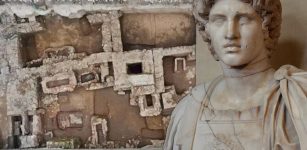 Amazing Photos Of Ancient Ruins Hidden Under Thessaloniki Metro Revealed By Archaeologists
Archaeology | Jan 9, 2023
Amazing Photos Of Ancient Ruins Hidden Under Thessaloniki Metro Revealed By Archaeologists
Archaeology | Jan 9, 2023 -
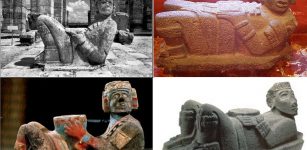 Image Of The Day: Chacmool – Famous Ancient Statue Of Pre-Columbian Mesoamerica
Image Of The Day | Sep 10, 2015
Image Of The Day: Chacmool – Famous Ancient Statue Of Pre-Columbian Mesoamerica
Image Of The Day | Sep 10, 2015 -
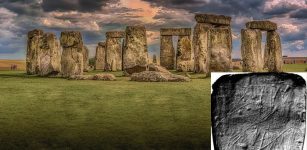 New Light On Prehistoric Chalk Plaques From Stonehenge Using Innovative Technology
Archaeology | Nov 3, 2021
New Light On Prehistoric Chalk Plaques From Stonehenge Using Innovative Technology
Archaeology | Nov 3, 2021 -
 Enigma Of The Solutrean People: Were First Americans European Stone Age People?
Ancient Mysteries | Sep 29, 2025
Enigma Of The Solutrean People: Were First Americans European Stone Age People?
Ancient Mysteries | Sep 29, 2025 -
 Undiscovered Neanderthal Artifacts From The Ice Age Are Submerged Below The Waves Of The English Channel
Archaeology | Nov 23, 2022
Undiscovered Neanderthal Artifacts From The Ice Age Are Submerged Below The Waves Of The English Channel
Archaeology | Nov 23, 2022 -
 Mystery Of The 3,500-Year-Old ‘Screaming Woman’ Mummy Solved
Archaeology | Aug 9, 2024
Mystery Of The 3,500-Year-Old ‘Screaming Woman’ Mummy Solved
Archaeology | Aug 9, 2024 -
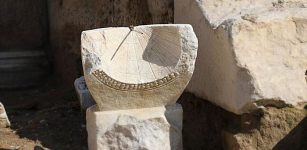 2,000-Year-Old Sundial Discovered In Ancient City Of Laodicea, Turkey
Archaeology | Mar 25, 2020
2,000-Year-Old Sundial Discovered In Ancient City Of Laodicea, Turkey
Archaeology | Mar 25, 2020 -
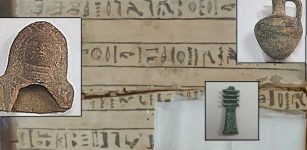 Smuggled Ancient Egyptian Artefacts Finally Arrive Home From Italy
Archaeology | May 16, 2023
Smuggled Ancient Egyptian Artefacts Finally Arrive Home From Italy
Archaeology | May 16, 2023 -
 Ancient DNA From Medieval Germany Reveals The True Story Of Ashkenazi Jews
Archaeology | Nov 28, 2022
Ancient DNA From Medieval Germany Reveals The True Story Of Ashkenazi Jews
Archaeology | Nov 28, 2022 -
 Secrets Of A Lake That Could Re-Write Ancient History Of America – Ancient Visitors From Distant Countries – Part 3
Ancient Mysteries | Jun 6, 2018
Secrets Of A Lake That Could Re-Write Ancient History Of America – Ancient Visitors From Distant Countries – Part 3
Ancient Mysteries | Jun 6, 2018

